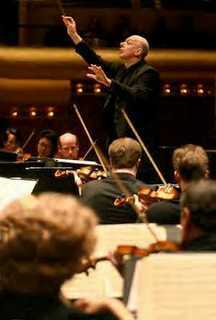|
Back
It’s The Thawed Which Counts New York
Avery Fisher Hall, Lincoln Center
02/24/2010 -
After the Thaw:
Alexander Lokshin: Symphony No. 4 (1968) (U.S. premiere)
Boris Tchaikovsky: Concerto for Cello and Symphonic Orchestra (1964) – Music for Orchestra (1987) (U.S. premiere)
Boris Tishchenko Symphony No. 5, Op. 67 (1976)
Anita Leuzinger (Cello)
American Symphony Orchestra, Leon Botstein (Music Director and Conductor)

Leon Botstein (©American Symphony Orchestra)
From dozens of composers who came out from the political closet into the open air of the Russian Republic, having been ignored or banned during the Soviet times, how did Leon Botstein choose the three composers who inhabited his program “After the Thaw?”
One story I heard is that Mr. Botstein had a meeting with Mstislav Rostropovich a few months before the conductor’s death, and was given a list of works which the cellist-conductor wanted to hear played in America. From this, Mr. Botstein chose three–ignoring, for some reason, wonderful choices like Kanchelli and Shchedrin–and offered this fascinating concert.
It was fascinating, and, typically for the gargantuan appetite of Mr. Botstein, it was 30 minutes too long. Unlike Mr. Botstein, most of us are merely human, and digesting four new works over two hours and 40 minutes is not easy. Thus, about 25 percent of the audience got up and left after the penultimate work. But Mr. Botstein and the American Symphony Orchestra plunged on, playing Boris Tchaikovsky’s charming Music for Orchestra. The first three movements could have been written by an American composer of the 1950’s (nothing Slavic, many sounds of nature and atmosphere), and while its 20 minutes length was hardly mind-bending, one felt that the concert offered far too much for mortals.
Truth be told, though, three of the four works, while produced after the fall of Stalin and Brezhnev, harked back to the clarion-call symphonies of Shostakovich. The other piece, Alexander Lokshin’s 15-minute Fourth Symphony was a bit more advanced, though the structure was uncomplicated.
Mr. Lokshin, like many of his colleagues, became a political prisoner in one of the Gulags. The program notes state that he may have been a camp spy. The truth is, that after nearly a quarter-century of assiduous detective work, Mr. Lokshin’s son has unearthed many many documents which state that these stories had no basis in fact.
This 1968 Symphony should have been simple to comprehend. It was an introduction with a theme and six variations. Those variations, though, were difficult to follow on first hearing. The orchestration was sometimes thick, hiding whatever melody was dashing around. And while some of it was clever, with bubbling horns, a marimba tune or two, and even a fughetta towards the end, the Symphony meaning was not easy. Mr. Lokshin did redeem himself at the end with the return of the original theme, but one would want to hear this again.
Repetition would hardly be necessary for Boris Tchaikovsky’s Cello Concerto, originally written for and performed by Mr. Rotstropovich in Washington. Boris Tchaikovsky was not–repeat not–related to the composer. In fact, his family was not even musical. But any American orchestra could program “Tchaikovsky’s Cello Concerto.” If the usual crowd would have been drawn in by imposture, they would still love the music.
This is an absolutely wonderful piece of music certainly the way it was played by 28-year-old Junoesque Swiss cellist Anita Leuzinger. The first notes of the concerto belonged to her, as did the next two movements, cello songs, played with bountiful aggressive sounds. For the first movement, she didn’t have a single measure at rest, but her bow flew over all the measures here, from the most elegiac to the feistiest.
The next two movements were pure Shostakovich, at his most sarcastic. The second movement started with cello and trombone having a colloquy on a kind of folk song. The tune resembled “Sweet Betsy of Pike”, but sung by a tone-deaf drunken cowpoke. Needless to say, so funny was this, that the whole orchestra came in for the hijinks. The third movement was a series of variations on plucked string ostinato.
The last movement was filled with fanfares, marches, some great vulgarity and a non-stop cello in the best Shostakovich tradition. Boris Tchaikovsky may not be an “original”, but this piece is a joy to hear.
Boris Tishchenko (the only living composer, now teaching in Russia) was never coy about his Shostakovich influence. A friend, a colleague, this Fifth Symphony was a total homage to the late composer, written in 1976. Five movements long (without a break), but very few measures without quotes from Shostakovich, a most imaginative use of the famed Shostakovich “motto” (D-Eb-C-B) but often disguised. Tischchenko also apparently quotes from himself (say the program notes), as if in colloquy with Shostakovich. I could not pick up on that (never having heard other works by Tishchenko), but the work was so well created, the Shosty quotes so clever, the final dance tune such a clever re-working of the “motto” that it was almost always scintillating.
And yes, Tishchenko had loads of fat along with the meat, but he could be forgiven. Just as Mr. Botstein could be forgiven for his “unheavenly length” since he and the ASO did thaw this music from the unforgivable political winters.
Harry Rolnick
|